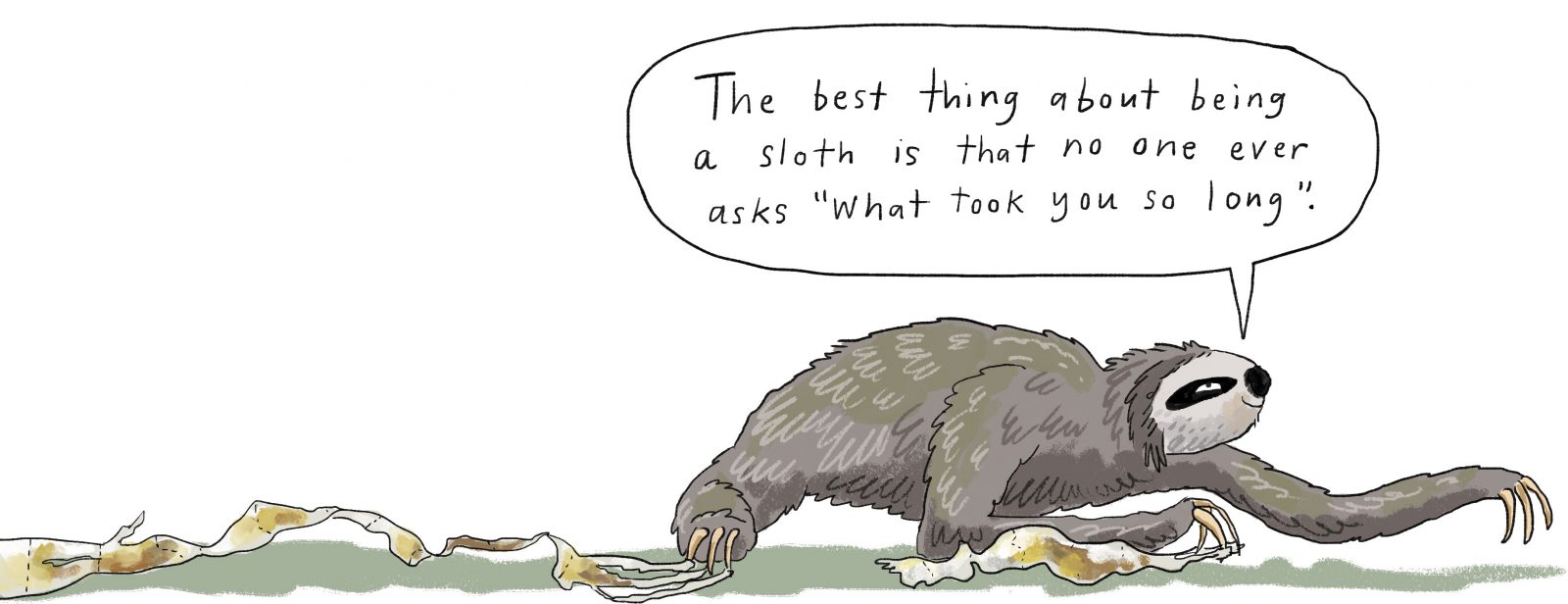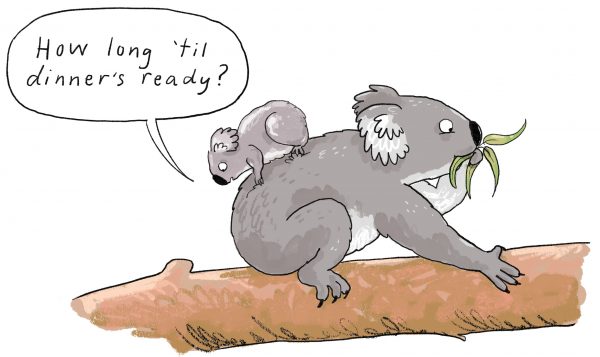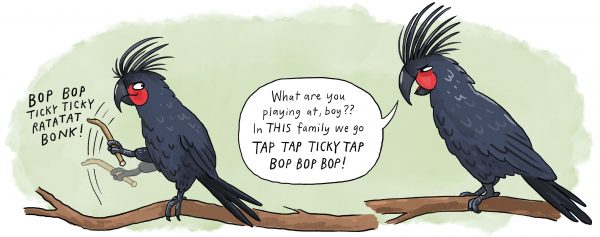The power of poo
Faeces have a lot to teach us. They can reveal secrets about the lives of extinct animals, and the troubles of endangered ones. Eating dung can give animals a nutrient boost—while in the oceans, a deluge of plankton poo powers the entire carbon cycle.

In 2021, scientists solved an important mystery: they finally got to the bottom of why wombats poo cubes. For years, people had wondered how the furry marsupial was able to sculpt such flat sides and neat corners with nothing but its butt hole (wait, you hadn’t?).
The researchers, from Australia and the United States, dissected a roadkill wombat and CT-scanned a live one. They found that wombats do not, as some had suggested, have a square-shaped anus. Instead, their intestines feature two unusually rigid portions, like stiff rubber bands, which constrict more quickly than the two soft sections. Using a mathematical model, the scientists showed that these subtle, irregular contractions gradually form each poo pellet into a cube as it travels through the animal’s gut.
Aside from the novelty, there may be an evolutionary advantage to this unusual ordure. Wombats use poo to mark territory, carefully arranging their two-cubic-centimetre calling cards on top of rocks and logs. Flat-sided scat is more likely to stay put.
For the past 500 million years, poo has been a part of life for most animals: eating food means generating some form of waste that must be excreted. Some creatures, such as jellyfish and flatworms, lack an anus, releasing waste through their mouths. Birds don’t separate faeces and urine, ejecting both through a single opening called the cloaca. Butterflies, which drink only nectar, don’t consume enough solids to poo at all—but their caterpillars certainly do. Some leaf-dwelling species use their ‘anal comb’ to catapult their frass up to 38 body lengths away from their nest; the exuberant toileting strategy is designed to confuse predators.

These malodorous waste products have huge value for science, however. Studying animal poo is a non-invasive way to reveal population sizes, genetic changes, and interactions between species, and to check up on individual creatures’ health.
University of Auckland microbial ecologist Annie West, for instance, has become a connoisseur of kākāpō poo. “It varies quite a bit in texture. Sometimes it’s a bit clay-ish. Other times it’s quite gritty and full of lots of different plant material. I think it’s probably a little bit like horse poo.”
Via such excrement, West and her colleagues discovered that the kākāpō gut microbiome is made up almost entirely of the common bacteria Escherichia coli. E. Coli is found in small proportions in our own digestive systems—with only some strains making us sick—but its dominance in kākāpō guts is extremely unusual. The only other animals so far recorded with a similarly bland microbiome are captive pandas.
“That was quite a strange finding,” says West, and it’s one we can’t yet explain. But learning more about the bacteria in the birds’ poo could help conservation managers keep kākāpō alive. “Birds don’t show obvious signs of being sick until they’re really sick,” West says, so changes in their gut microbiome could provide an early warning of disease or poor health. Such research also raises the possibility of intervention via probiotics or faecal transplants—something that’s already being tried with koalas.
[Chapter Break]
As poo goes, koala turds are particularly inoffensive, says Ben Moore, an ecologist at the University of Western Sydney. He realised he’d been spoiled when he was asked to analyse echidna poo: “That stuff was rank!” Koala poo, on the other hand, is the size, shape, and colour of olives, and smells almost pleasantly of eucalyptus.
That’s good news for baby koalas, since they have to eat it. Many animals practise coprophagy—crap-eating, in Ancient Greek. Thousands of species of beetles and flies subsist on the droppings of larger herbivores, while sloths in the Amazon have repeatedly been observed climbing down from the trees to eat human waste from long drops.
Rabbits, hares and guinea pigs excrete soft pellets that they immediately eat and re-digest, allowing them to extract extra nutrients. And in Uganda, mountain gorillas have occasionally been recorded eating their own faeces. Researchers suggested this was less about nutrition than boredom, or perhaps “the craving for warm food on cold days”.

Young koalas, like ringtail possums and giant pandas, feed on pap, which Moore describes as “special runny pasty faeces” their mother produces when her joeys are ready to be weaned. The babies lap it up, and it helps to seed their gut microbiome.
Moore thought about that delightful adaptation when he was trying to solve a koala fussy-eating problem. In Queensland and New South Wales, koalas are critically endangered, but in Victoria’s Cape Otway, they sometimes breed in plague proportions, stripping certain kinds of eucalyptus of their leaves until both trees and animals die. “You can see 10 koalas in a tree occasionally,” he says. “It’s extraordinary.”

For koalas, manna gum leaves are manna from heaven, and most of the Cape Otway mob, it seemed, would rather starve than eat anything else. A few, however, were dining in the neighbouring messmate gum trees. What was it that enabled those individuals to diversify their diet, Moore wondered?
The answer was in their poo.
Koalas produce hundreds of pellets a day, even in their sleep, so the stuff was easy to come by. “It’s very non-invasive; you just pick up the fresh turds from under a koala,” Moore says. When the scientists analysed the DNA inside, it turned out that the messmate-eating koalas had a markedly different microbiome than the ones that ate only manna.

The next question was, could a poo transplant help? To find out, Moore gathered fresh poo from beneath the messmate-eating koalas every morning, mashed it up in a bag with a buffer, and then fed the mixture into an ancient centrifuge. The animals’ gut bacteria collected in a film on the surface of the poo smoothie, and the scientists scooped it up and put it into capsules, feeding them to the fussy koalas for 10 days. It didn’t work for all of them. But those koalas whose microbiome changed to feature more of the messmate-associated bacteria suddenly found they had a liking for messmate.
Koalas are frequently brought into care after bushfires or contracting chlamydia—an endemic problem for the species, which is both sexually transmitted and spread to young koalas through their mothers’ pap. Treatment consists of heavy doses of antibiotics.
After such carpet-bombing, faecal transplants and population-specific koala probiotics could help restore a functioning microbiome, Moore suggests, and allow koalas to thrive on the local foliage when they’re translocated to new forests. “For a koala, being able to feed on the best leaf available is really critical to its chance of survival.”
[Chapter Break]
Fresh poo can be waste, food, or medicine—researchers have even made a powerful anti-salmonella antibiotic from muskrat dung. Ancient excrement, meanwhile, contains a goldmine of information about extinct animals and lost ecosystems. “Bones tell us what animals were present, and pollen tells us about the plants,” says Jamie Wood, a New Zealand palaeoecologist now based at the University of Adelaide. “But it doesn’t tell us the interactions between those things. Ancient dung is actually one of the only ways we can get at that sort of information—it records interactions between species.”
Fossilised droppings are called coprolites, and scientists have used fossil pollen grains, leaf cuticles, and parasite eggs in dinosaur dung to figure out what the giant reptiles ate and what was living in their guts. But the dried-out poos Wood works with are hundreds or thousands of years old, not millions, and they haven’t yet been turned to stone—meaning these “palaeo-poos” still have usable DNA preserved inside them.

Since 2006, Wood has been scrambling around South Island caves collecting thousands of moa stools: heavy, handful-sized droppings with a distinctive lobed surface reminiscent of a lava flow. Before then, only around 50 moa poos had ever been found, and they were so precious that no-one wanted to destroy them for analysis. Instead, everything known about moa diet was inferred from their gizzard contents—little piles of twigs, leaves and sticks preserved alongside moa skeletons excavated from swamps.
The trouble is, the last meal of a bird trapped in a bog isn’t exactly representative of its normal diet. “The great thing about coprolites is they’re completely unbiased, because the animal’s living in its natural environment,” Wood says. While gizzard contents suggested moa reached up into the canopy, eating the twigs and seeds of tall trees, Wood’s genetics studies revealed that many moa species were more sheep than giraffe, grazing instead on flowering herbs and grasses.

The droppings of the South Island giant moa (Dinornis robustus) were particularly strange. Half of them showed the birds were feeding in the forest understory, eating beech and coprosma. The other half contained the DNA of fruits and herbs found in open country.
Since female giant moa towered over their mates—they could weigh nearly three times as much as males—and it’s mostly female remains that have been found in forest locations, Wood’s theory is that the genders lived almost completely separate lives, with the larger females opting for the large quantities of low-nutrient food available in the forests. “I’m kind of fascinated by this. There can’t be too many examples of niche separation between males and females in a single species. But the huge size difference between them suggests they might have been doing something different.”
[Chapter Break]
More recently, Wood and his colleagues have been using moa poo to try to figure out why New Zealand fungi are so colourful. Overseas, truffles are typically dull brown or off-white, and often grow underground. They are dispersed by mammals: chipmunks and squirrels in North America, possums and kangaroos in Australia. These animals sniff out, dig up and eat the truffles, carry their spores around in their guts, and release them in a new location when they defecate.
New Zealand has few mammals, and 200 species of truffle, many of which look like they are pretending to be fruit. They are round, shiny, and painted in all the colours of the rainbow: magenta, scarlet, orange, yellow, lavender, bluish-green, and brilliant white. Could sharp-sighted birds be doing the dispersal job instead?
“One of the problems is no one’s actually seen birds eating these things,” says Wood. “So we had the idea that maybe it was moa, or other extinct birds, that were doing the eating and the dispersing.” When the researchers analysed the DNA in Wood’s stash of moa poo, they did find genetic material from these types of fungi.
They also simulated what the truffles would look like in a moa’s-eye-view, using what they’ve learned about the extinct birds’ vision. “What we’ve found is that the fungi appear very, very visually similar to fruit.” Our fruity fungi often grow on the surface, contrasting nicely with the leaf litter—more circumstantial evidence pointing to moa as key dispersal agents.

We don’t yet know how the disappearance of moa from New Zealand forests has affected these technicolor truffles. But we do know that when the last moa died, more than one species went extinct. Analysing 84 moa coprolites, Wood’s team found the eggs and genetic material from half a dozen different types of parasite, some of which seem to have been host-specific. The digestive systems of moa were their whole world—and when the world was gone, they had nowhere else to live. This is called co-extinction, Wood says. “It’s this major process of biodiversity loss, but we don’t yet understand anything about it.”
Losing parasites might not seem like something to cry over, but “we’re losing species, no matter what”, says Wood. “They still have evolutionary histories, they’re still part of the world.” Paradoxically, some parasites can actually be good for their hosts—training their immune systems in ways that can outweigh the negative effects. “Conserving parasites is quite important,” Wood says.
[Chapter Break]
Even more important—for the climate, at least—is the daily downpour of poo taking place in the world’s oceans.
Every day, tiny floating organisms called phytoplankton trap carbon from the atmosphere in their bodies when they photosynthesise. These almost-plants are the favourite food of Antarctic krill (Euphausia superba), a shrimp-like crustacean about the size of your finger.
Antarctic krill get together in vast numbers—their swarms are the biggest in the animal kingdom—and their habitat stretches 19 million square kilometres around the Antarctic continent. Their combined body weight across the Southern Ocean has been estimated at between 200 and 300 million tonnes.
Scientists haven’t yet determined how much poo an individual krill produces over its five- to six-year lifetime, but it almost certainly far exceeds its body weight, says Emma Cavan from Imperial College London, known to her colleagues as “Dr Plankton Poo”. “They’re doing it all day, every day. When you add it all up, it’s a pretty large amount of carbon.” (For context, humans are estimated to produce around 146 kilograms of poo annually, adding up to 11,680 kilograms after 80 years on the planet—a mass of manure equivalent to seven or eight adult male hippopotamuses.)

It’s not just the quantity, but the quality, too: krill poo is especially well designed for carbon storage. The crustaceans produce large yellow “faecal strings”, which have good structural integrity, Cavan says. “They have a kind of membrane around them, like a sausage lining, which helps to keep it all compact.”
When krill swarm, they’re so numerous that not all their poo is eaten by other animals, and plenty of their solid, heavy faecal pellets sink quickly away from the surface and into the deep. The whole cycle acts as a pump, drawing carbon out of the atmosphere and transporting it into the ocean’s depths, keeping it there for centuries, even millennia—depending on the specific location, depth, and currents.
Krill aren’t the only producers of this precious rain of poo. Other kinds of plankton, copepods, and small fish such as anchovies, sardines and pilchards also contribute carbon-rich faecal pellets to ocean sediments. Then there’s the mega-manure: whales dump tonnes of dung into the water each day. These fluffy, fleecy plumes of liquid poo can measure as much as 200 litres per bowel movement, contain lumps of valuable ambergris, and vary in colour from neon yellow to scoria red. What’s more, the iron they release into the surrounding ocean is crucial for seeding the phytoplankton blooms that in turn allow krill to flourish. It’s a fabulous faecal cycle of life.

















